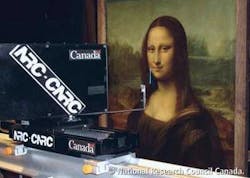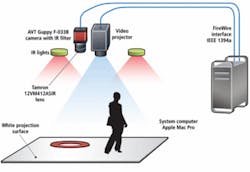3-D imaging unveils Mona Lisa
The Mona Lisa was painted on a poplar wood panel by Leonardo da Vinci between 1503 and 1506, and is one of the jewels of the Louvre museum in Paris. From June to October 2008, the Musée national des beaux-arts du Québec (Quebec, QC, Canada) presented some of the results of a 3-D examination of the Mona Lisa conducted by the National Research Council Canada (NRC), during the Le Louvre à Québec exhibition. The results were shown continuously in a high-definition plasma screen.
The document produced by the NRC shows digital images of how the painting was created. For the project, a 3-D color laser scanner built by NRC was brought to Paris in October 2004 to scan the front, back, and edges of the complete painting. The triangulation-based system scanned a low-power white laser spot over the painting to produce a high-resolution archival quality 3-D digital model of the shape and color of the surface. The laser scanner was mounted on a linear translation stage, which moved the scanner across the surface to acquire successive scan bands 4 cm in width. The scanner recorded the shape and color of the painting at a lateral resolution of 60 × 60 µm and at a depth resolution of 10 µm—revealing also that a 12-mm warp had occurred over time.
FPGAs speed iris recognition
Iris recognition is one of the most accurate biometric identification methods available, with custom algorithms deployed globally in a variety of systems ranging from personal computers to portable scanners. These systems must reliably match a new template with one previously enrolled. The newly encoded iris is then compared to a database using a fractional hamming distance (HD) calculation. Ryan Rakvic and his colleagues at Southern Methodist University (Dallas, TX, USA; www.smu.edu) have implemented this HD calculation using VHDL on a modern FPGA, and compared performance against a state-of-the-art CPU.
The CPU used for this experiment was an Intel Xeon X5355 workstation-class machine, while the FPGA was executed on a DE2 board from Altera, which includes a Cyclone-II EP2C35 chip. Execution and acceleration times indicated 383 ns per match for the optimized Xeon version versus 20 ns per match for the FPGA. Thus, the principal result so far demonstrates that the HD calculation on a FPGA of modest size is approximately 19 times faster than a state-of-the-art CPU design. Given traditional scaling of FPGAs, the algorithm running on a Stratix IV FPGA clocked at 500 MHz would perform a match in 2 ns.
Camera plunges to the depths
An underwater camera has plunged to record-breaking depths below the surface of the North Sea. Claimed to be the only camera of its kind in the world, the eHoloCam is a 3-D holographic camera used by researchers at the University of Aberdeen (Aberdeen, UK; www.abdn.ac.uk) to capture images of underwater organisms and living particles to provide scientists with a greater understanding of marine life. The camera produced the deepest hologram ever to be recorded, traveling 450 m below the surface of the North Sea, when it was deployed by the RV Scotia, a research vessel owned by the Fisheries Research Services Marine Laboratory.
The camera records holograms of tiny subsea organisms such as plankton that hold crucial indicators and clues to increase the understanding of oceans and the impact on our global environment. Detailed holographic images of these organisms, which range in size from a few microns to several millimeters, are essential for the marine biology community, providing vital
Machine vision makes a virtual stage
Image processing is finding new markets such as advertising, as demonstrated by Allied Vision Technologies (AVT; Stadtroda, Germany; www.alliedvisiontec.com) in its exhibition booth at VISION 2008 in Stuttgart. In the Virtual Stage display, an image of the surface of a pond was projected onto the floor of the booth. Each step on the image sets off ripples, and goldfish flee from the foot. The virtual pond could be easily replaced by a pile of leaves, which fly around the visitor as though walking through real foliage.
The Virtual Stage was designed by Mobidium (Paris, France; www.mobidium.fr), a developer of interactive multimedia applications, with help from IMASYS (Suresnes, France; www.imasys.fr), part of the Stemmer Imaging Group. In the display, a monochrome Guppy FireWire camera from AVT captures motion and software analyzes it to alter the image with a corresponding effect. The key is to connect several projectors and cameras in series, so the system can create surfaces of any size in a mosaic pattern with a large background image. The Virtual Stage has been used at functions such as trade fairs, fashion shows, and point-of-sale locations.


